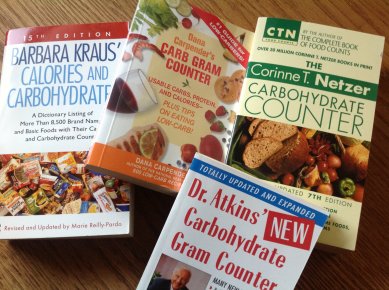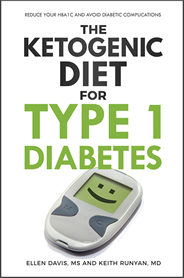Carb Counter Resource
Here's a list of various carb counter pages to get you started on counting your carbohydrate intake. You can use these charts to track the carbohydrate amounts in your meals until you pick up a more comprehensive book. I've recommended some at the bottom of this page, and also at right.
Counting carbs is an important part of being successful on a ketogenic diet, so I highly recommend learning how to do it. At home, or in the office, you can keep a copy of your favorite carb gram counter book.
Over time, you'll get very good at estimating the amount of carbohydrates in foods, but having a list to which you can refer is always handy.

Depending on the chart, it may include the food description, a calorie count, net carbs (carbs minus fiber) and the amount of protein in that food serving.
- Protein chart: This protein chart lists the most popular types of protein rich foods along with their carb and protein grams.
- Vegetables: Most green leafy vegetables have very little carb. Some of the more starchy vegetables (potatoes, corn, peas) have as much or more carbs than fruit, so you'll want to track those closely or avoid them all together.
- Fruit: The carbs in fruit can add up quickly. Track your serving sizes closely.
- Fats: Fats don't have any carbs in them, so they all count as 0 carbs. This would include butter, olive oil, lard, tallow, coconut oil, palm oil, bacon fat, and vegetable oils.
- Dairy Products: Dairy products are generally lower carb, as long as you stick to the full fat varieties. Milk has the most carb. Yogurt and cottage cheese have less, and the firm and hard cheeses having the least carb. Very high fat cheese such as brie is very low in carb.
- Nuts And Seeds: Some nuts are low in carb, while others are high. It's a good idea to track the amounts and types you eat, and limit them as they are also high in calories and volatile polyunsaturated fats.
- Condiments: Generally, anything with a tomato or fruit base is higher in carb, so ketchup, chutneys and chili sauce are carby. Fat based condiments such as tartar sauce and mayonnaise are less carby.
I also recommend picking up a carb counter book that you can carry with you. These are my go-to books:
A Note on Carb Counters on Food Labels
Yes, you can get the carb count of a food from the food label, but be aware food manufacturers have a habit of fudging the amount of carbs in their products. And you have to remember to check serving sizes as well. If you are looking at a large container of yogurt, and it says 16 carbs per serving, make sure you check to see if there is more than on serving in the container. If there are two servings, than the total carb count for that container is 32, not 16.
All of my books are available in electronic PDF, and now in paperback on Amazon!
 |
 |
 |
|
Buy paperbook on Buy paperback on Amazon Buy the e-Book via Paypal |
Buy paperback on Buy paperback on Amazon Buy the e-Book via Paypal |
Buy paperback on Buy paperback on Amazon Buy the e-Book via PayPal |